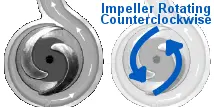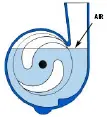What Is The Differences Between Self-Priming Pump And Centrifugal Pump?
The word "self-priming pump" describes a centrifugal pump that may make use of an air-water mixture to achieve a completely-primed pumping condition.
First, let us define a centrifugal pump:
A centrifugal pump is any pump that utilizes centrifugal pressure to produce a pressure differential inside a fluid, thus leading to pumping action.
The simplest way to visualise this course of action would be to imagine the consequence of vehicle tire flicking water off a wet road. The pumping action isn't from the "scooping" action through the vanes (the blade-like wings) around the impeller, but instead in the centrifugal pressure

Standard (non-self-priming) centrifugal pumps are available in many different kinds. Once they work on flooded suction lines or perhaps in submersible applications, the impeller is encircled by enough water to produce pressure differential and therefore to function water.
Air may be the primary enemy of the standard (non-self-priming) centrifugal pump. Once the standard centrifugal pump encounters air, it may become air-bound. It's more difficult to function air rather than pump water, then when the environment "binds" the pump, the pump can't pressure water out.
When everything's working right, a typical (non-self-priming) centrifugal pump works such as this:

When air will get right into a standard (non-self-priming) centrifugal pump, the pump becomes air-bound, such as this:

If this air-binding happens, the pump is stuck. It will not operate before the air can be taken off in some manner.
So, you may ask, why aren't these pumps made to pump air in addition to water? The reply is that water and air have different qualities. You would not make use of a ceiling fan instead of a onboard motor inside a fishing-boat, exactly like you wouldn't make use of a sump pump to operate your ac. Water is a lot more dense than air, therefore the blades accustomed to move air could be much flimsier but need to move considerably faster. To maneuver water, the blades need to be much sturdier, however they can move a lot more gradually. The propeller blades on the cruiseship turn around 100 Revoltions per minute, while a jet turbofan engine turns at 10,000 Revoltions per minute or even more.
What's Different In regards to a Self-Priming Pump?
A "self-priming" centrifugal pump overcomes the issue of air binding by mixing air with water to produce a fluid with pumping qualities similar to individuals of standard water. The pump then will get eliminate the environment and moves water only, as being a standard centrifugal pump.
You should realize that self-priming pumps cannot operate without water within the casing.
Here's how it operates:
Throughout the priming cycle, air enters the pump and mixes with water in the impeller. Water and air are discharged together by centrifugal action from the impeller in to the water reservoir. The environment naturally has a tendency to rise, as the water has a tendency to sink.

Air-free water, now heavier than air-laden water, flows by gravity back lower in to the impeller chamber, prepared to mix with increased air arriving the suction line. Once all air continues to be evacuated along with a vacuum produced within the suction line, atmospheric pressure forces water up in to the suction line for the impeller, and pumping begins.

Recirculation water inside the pump stops when pumping begins. Next time the pump is began, it'll "self-prime" -- that's, it can once more mix water and air within the casing to produce a pumpable fluid before the pump is fully primed again.

This kind of pump is different from a typical centrifugal pump for the reason that it features a water reservoir included in the system allowing it to rid pump and suction type of air by recirculating water inside the pump on priming cycle. This water reservoir might be over the impeller or while watching impeller. Either in situation, the "self-priming" capacity from the pump originates from the pump's capability to retain water after the initial prime.
So Can One Just Begin a Self-Priming Pump Whenever, Even When It's Dry Inside?
No. A self-priming centrifugal pump should have water within the casing to be able to operate. You can't pull any self-priming pump away from the box, switch it on, and expect it to function. Whether it's filled with air, it will not prime. "Self-priming" refers back to the pump's capability to frequently turn an auraOrdrinking water mixture right into a pumpable fluid -- NOT the opportunity to produce a vacuum (literally) from nothing. Actually, you shouldn't attempt to operate a self-priming pump without water within the casing. It's harmful and can frequently result in seal failure.
Click Here To Learn More About Our Self-priming Pump Products Ranges
Next: What Is Safety Valve?